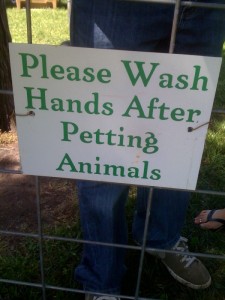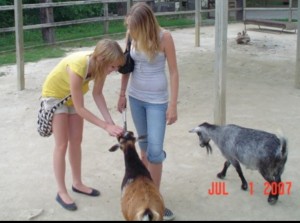Here’s an example of terrible story-telling.
 According to news reporting out of Bilthoven, Netherlands, by VerticalNews editors, research stated, “The significance of petting zoos for transmission of Campylobacter to humans and the effect of interventions were estimated. A stochastic QMRA model simulating a child or adult visiting a Dutch petting zoo was built.”
According to news reporting out of Bilthoven, Netherlands, by VerticalNews editors, research stated, “The significance of petting zoos for transmission of Campylobacter to humans and the effect of interventions were estimated. A stochastic QMRA model simulating a child or adult visiting a Dutch petting zoo was built.”
Our news journalists obtained a quote from the research from National Institute for Public Health and the Environment, “The model describes the transmission of Campylobacter in animal feces from the various animal species, fences, and the playground to ingestion by visitors through touching these so-called carriers and subsequently touching their lips. Extensive field and laboratory research was done to fulfill data needs. Fecal contamination on all carriers was measured by swabbing in 10 petting zoos, using Escherichia coli as an indicator. Carrier-hand and hand-lip touching frequencies were estimated by, in total, 13 days of observations of visitors by two observers at two petting zoos. The transmission from carrier to hand and from hand to lip by touching was measured using preapplied cow feces to which E. coli WG5 was added as an indicator. Via a Beta-Poisson dose-response function, the number of Campylobacter cases for the whole of the Netherlands (16 million population) in a year was estimated at 187 and 52 for children and adults, respectively, so 239 in total. This is significantly lower than previous QMRA results on chicken fillet and drinking water consumption. Scenarios of 90% reduction of the contamination (meant to mimic cleaning) of all fences and just goat fences reduces the number of cases by 82% and 75%, respectively.”
According to the news editors, the research concluded: “The model can easily be adapted for other fecally transmitted pathogens.”
For more information on this research see: A Quantitative Microbiological Risk Assessment for Campylobacter in Petting Zoos. Risk Analysis, 2014;34(9):1618-1638. Risk Analysis can be contacted at: Wiley-Blackwell, 111 River St, Hoboken 07030-5774, NJ, USA. (Wiley-Blackwell – www.wiley.com/; Risk Analysis – onlinelibrary.wiley.com/journal/10.1111/(ISSN)1539-6924)
Going to a petting zoo? People need to be a lot more careful than they thought
The other parents hate me.
Even Amy changed her phone ring to the Debbie Downer noise from Saturday Night Live.
I’m Dougie Downer.
Every time there’s a sausage sizzle, I don’t complain, I cook for the kids and their families, and use a thermometer.
People think I’m weird.
The chicken coop at the daycare is still empty. And while no one will say it, I’m sure they blame me for depriving their little ones of chick interaction (and Salmonella).
This is nothing new; I’ve been causing angst or disgust for about 20 years, going with my kids on those field trips to the farm (the oldest of five daughters is 25; I’m ancient).
Besides, Gonzalo Erdozain did most of the work on this petting zoo paper, and he’s got a little one, so he can torment the parents of Roman’s future classmates.
Kansas State University came out with their version of our petting zoo paper and quoted me, as saying “People have to be careful — a lot more careful than they thought.”
Powell is co-author of the paper “Observation of Public Health Risk Behaviors, Risk Communication and Hand Hygiene at Kansas and Missouri Petting Zoos – 2010-2011″ that was published recently in the journal Zoonoses and Public Health.
 The paper’s main author is Gonzalo Erdozain, a master of public health student at the Kansas State University who works with Powell. Erdozain, Manhattan, visited numerous petting zoos and fairs in Kansas and Missouri in 2010 and 2011 and found many sanitary problems at the facilities. Article co-authors include Katherine KuKanich, assistant professor of clinical sciences at Kansas State University, and Ben Chapman of North Carolina State University.
The paper’s main author is Gonzalo Erdozain, a master of public health student at the Kansas State University who works with Powell. Erdozain, Manhattan, visited numerous petting zoos and fairs in Kansas and Missouri in 2010 and 2011 and found many sanitary problems at the facilities. Article co-authors include Katherine KuKanich, assistant professor of clinical sciences at Kansas State University, and Ben Chapman of North Carolina State University.
When visiting petting zoos, Powell said parents need to be vigilant in watching their children and they need to put a health plan in effect for the visit. In Erdozain’s study, he observed children touching their faces after petting the animals, eating or drinking in the petting zoo, eating petting zoo food and sucking on a pacifier while at the zoo. Children were also seen picking up animal feces.
Another factor to watch for is the presence of high-risk animals — those most associated with zoonotic diseases, including chicks, young ruminants like goats, sheep and cattle.
Zoonotic diseases can be passed from animal to human, or vice versa.
Washing hands before and after encountering animals and the animal feed is one of the most recommended method to fight germs and bacteria from the animals and surrounding area of animal pens, Powell said.
“Hand-washing tool selection may also contribute to the success of hand hygiene as a preventive measure, as some outbreak investigations have reported alcohol-based hand sanitizer was not protective against illness, especially when hands are soiled,” Powell said.
Powell said Erdozain’s study found that visitors were five times as likely to wash their hands when a staff member was present. This observation, Powell said, is consistent with a study published last year that showed the importance of a little encouragement.
To help maintain a safe and healthy environment, Powell said petting zoos should constantly remind visitors to wash their hands when exiting the pens. Keeping clean and useful sinks near the exits of all facilities with a stand by attendant would help decrease the likeliness of a widespread illness due to forgetful hygiene, he said.
Strict governmental regulation and enforcement would be one way to ensure this happens but is an unlikely solution. Powell said that it is up to the zoos to help keep watch on what is happening within their pens and to make sure that the proper facilities are in place and are noticeable to visitors — children and adults alike.
“Providing hand hygiene stations, putting up some good signs, having staff supervise, avoiding high-risk animals and logical facility design are easy and inexpensive — and not doing so is inexcusable,” Powell said.
I’m fine with animal interactions; but people, and organizers, should be a lot more careful than they thought. That’s what I told my 3-year-old’s daycare as they prepared for a chicken coop. They hate me.
A table of petting zoo outbreaks is available at http://bites.ksu.edu/petting-zoos-outbreaks.
Erdozain G, Kukanich K, Chapman B, Powell D. 2012. Observation of public health risk behaviours, risk communication and hand hygiene at Kansas and Missouri petting zoos – 2010-2011. Zoonoses Public Health. 2012 Jul 30. doi: 10.1111/j.1863-2378.2012.01531.x. [Epub ahead of print]
Abstract below:
Observation of public health risk behaviors, risk communication and hand hygiene at Kansas and Missouri petting zoos – 2010-2011Outbreaks of human illness have been linked to visiting settings with animal contact throughout developed countries. This paper details an observational study of hand hygiene tool availability and recommendations; frequency of risky behavior; and, handwashing attempts by visitors in Kansas (9) and Missouri (4), U.S., petting zoos. Handwashing signs and hand hygiene stations were available at the exit of animal-contact areas in 10/13 and 8/13 petting zoos respectively. Risky behaviors were observed being performed at all petting zoos by at least one visitor. Frequently observed behaviors were: children (10/13 petting zoos) and adults (9/13 petting zoos) touching hands to face within animal-contact areas; animals licking children’s and adults’ hands (7/13 and 4/13 petting zoos, respectively); and children and adults drinking within animal-contact areas (5/13 petting zoos each). Of 574 visitors observed for hand hygiene when exiting animal-contact areas, 37% (n=214) of individuals attempted some type of hand hygiene, with male adults, female adults, and children attempting at similar rates (32%, 40%, and 37% respectively). Visitors were 4.8x more likely to wash their hands when a staff member was present within or at the exit to the animal-contact area (136/231, 59%) than when no staff member was present (78/343, 23%; p<0.001, OR=4.863, 95% C.I.=3.380-6.998). Visitors at zoos with a fence as a partial barrier to human-animal contact were 2.3x more likely to wash their hands (188/460, 40.9%) than visitors allowed to enter the animals’ yard for contact (26/114, 22.8%; p<0.001, OR= 2.339, 95% CI= 1.454-3.763). Inconsistencies existed in tool availability, signage, and supervision of animal-contact. Risk communication was poor, with few petting zoos outlining risks associated with animal-contact, or providing recommendations for precautions to be taken to reduce these risks.
